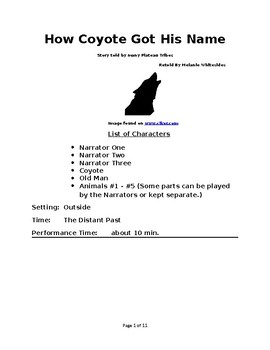How Coyote Got His Name - A Small Group Reader's Theater
- Word Document File
Description
This is a Native American tale about how Coyote got his name. This is for 5 to 9 students. He features prominently in a lot of stories of the Navajo and in many other tribes. I first saw this one online but have heard it from our Navajo teacher since.
I use reader's theaters to encourage my students to practice fluency. It is a fun way to do something that they need. Most of my scripts are in black and white so they photo copy easily. This one does have a colored picture on the first page but the rest is black and white.
The problem with many other reader's theaters is that students spend a lot of time waiting for their part. When you have a small group they get more practice in and less off task behaviors take place. If you like this script check out some of my others based on Native American tales at my store. I even have an entire book of them called Coyote Tales!
My name is Melanie Whitesides but my store name is Wonbyone and I hope that your students enjoy this script as much as mine did. Let me know how things go!
How Coyote Got His Name A Plateau Tribe Tale by Melanie Whitesides is licensed under a Creative Commons Attribution-NonCommercial-ShareAlike 3.0 Unported License.





